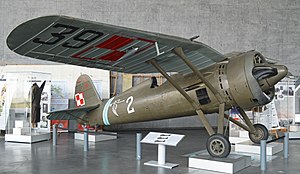| PZL P.11 | |
|---|---|
 The sole surviving P.11 on display in the Polish Aviation Museum | |
| General information | |
| Type | Fighter |
| Manufacturer | Państwowe Zakłady Lotnicze Industria Aeronautică Română |
| Designer | |
| Primary users | Polish Air Force |
| Number built | 325[1] |
| History | |
| Introduction date | 1934 |
| First flight | August 1931[1] |
| Retired | 1944 |
| Developed into | PZL P.24 |
The PZL P.11 is a Polish fighter aircraft, designed and produced in the early 1930s by Państwowe Zakłady Lotnicze. Possessing an all-metal structure, metal-covering, and high-mounted gull wing, the type held the distinction of being widely considered the most advanced fighter aircraft in the world at the time of its introduction into service.[1]
Work on the PZL P.11 began in the 1930, based on experience with previous aircraft from the family of fighters derived from the PZL P.1. The primary individual responsible for their development was Polish aeronautical engineer Zygmunt Puławski, who has been attributed as having designed many of their innovative features. While most of the world's air forces still operated biplanes in the early 1930s, the P.11, like previous aircraft in the Puławski family, used a high-mounted and aerodynamically clean gull wing that produced less drag and provided the pilot with a superior field of view. In August 1931, the first prototype conducted its maiden flight. The design quickly drew international attention; the general layout became commonly known as the "Polish wing" or "Puławski wing".
The PZL P.11 served as the basic fighter of the Polish Military Aviation in the second half of the 1930s, including during the German-Soviet invasion of Poland. However, as a consequence of the rapid advances in aircraft development during the late 1930s (seen in such fighters as the Messerschmitt Bf 109), it was outclassed by its rivals at the onset of the war.[1] A significant number of Polish P.11s were destroyed on the ground in the first days of the Second World War; however, many fighter squadrons took up an unequal fight, achieving some successes. It is estimated that as many as 36 P.11s were evacuated to Romania and were subsequently taken over by the Royal Romanian Air Force.
In the early 1930s, the PZL P.11 won a contract for a new fighter aircraft for the Royal Romanian Air Force. During October 1933, deliveries of Polish-built P.11b to Romania commenced.[2] From 1936, Romanian aircraft manufacturer Industria Aeronautică Română (IAR) license-built a further 95 aircraft under the designation IAR P.11f, powered by the Romanian-built IAR 9Krse engines.[3] A more advanced development of the PZL P.11, which achieved much greater export success, was the PZL P.24. In the mid-1930s, several countries expressed their willingness to purchase the PZL P.11, of which Turkey, Bulgaria and Greece decided to acquire the new PZL P.24 instead.[1][4]
- ^ a b c d e Cynk, Jerzy B. (1971). Polish Aircraft 1893-1939 (1st ed.). London: Putnam & Company Ltd. pp. 158–172. ISBN 0-370-00103-6.
- ^ Cite error: The named reference
AE28 p43was invoked but never defined (see the help page). - ^ Cite error: The named reference
morg63was invoked but never defined (see the help page). - ^ Cite error: The named reference
Winchester p. 219was invoked but never defined (see the help page).